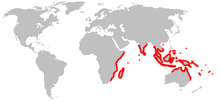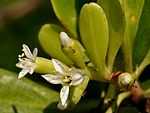Lumnitzera
| Lumnitzera | |
|---|---|
| | |
| Lumnitzera racemosa (flowering) - Kung Krabaen, Chantaburi province, Thailand | |
| Scientific classification | |
| Kingdom: | Plantae |
| (unranked): | Angiosperms |
| (unranked): | Eudicots |
| (unranked): | Rosids |
| Order: | Myrtales |
| Family: | Combretaceae |
| Genus: | Lumnitzera Willd. (1803)[1] |
| Species | |
|
L. littorea | |
 | |
| Range of Lumnitzera[1] | |
Lumnitzera is an Indo-West Pacific mangrove genus in the family Combretaceae. The English common name is Black Mangrove. Lumnitzera, named after the German botanist, Stephan Lumnitzer (1750-1806), occurs in mangroves from East Africa to the Western Pacific (including Fiji and Tonga), and northern Australia.[1]


The genus has two species of similar vegetative appearance but with differing flower colour. Lumnitzera littorea has red flowers whereas Lumnitzera racemosa has white flowers. Both species have flat and spoon-shaped (spathulate) leaves with emarginate tips. L. racemosa dominates in the western part of the range and L. littorea dominates in the east. Hybrids occur within the zone of overlap (Lumnitzera × rosea).[1]
Three genera of the tropical woody family Combretaceae, Laguncularia, Conocarpus, and Lumnitzera, are found in mangroves but Lumnitzera is the only one to occur in the Indo-West Pacific mangroves, including Australia.[1]
Lumnitzera racemosa var. racemosa (Tonga mangrove, Afrikaans: Tonga-wortelboom, Zulu: Isikhaha-esibomvu) is a protected tree in South Africa.[2]
See also
- List of Southern African indigenous trees
References
- ↑ 1.0 1.1 1.2 1.3 1.4 "Lumnitzera". University of Queensland. Retrieved 30 June 2010.
- ↑ "Protected Trees". Department of Water Affairs and Forestry, Republic of South Africa. 3 May 2013.
External links
![]() Media related to Lumnitzera at Wikimedia Commons
Media related to Lumnitzera at Wikimedia Commons